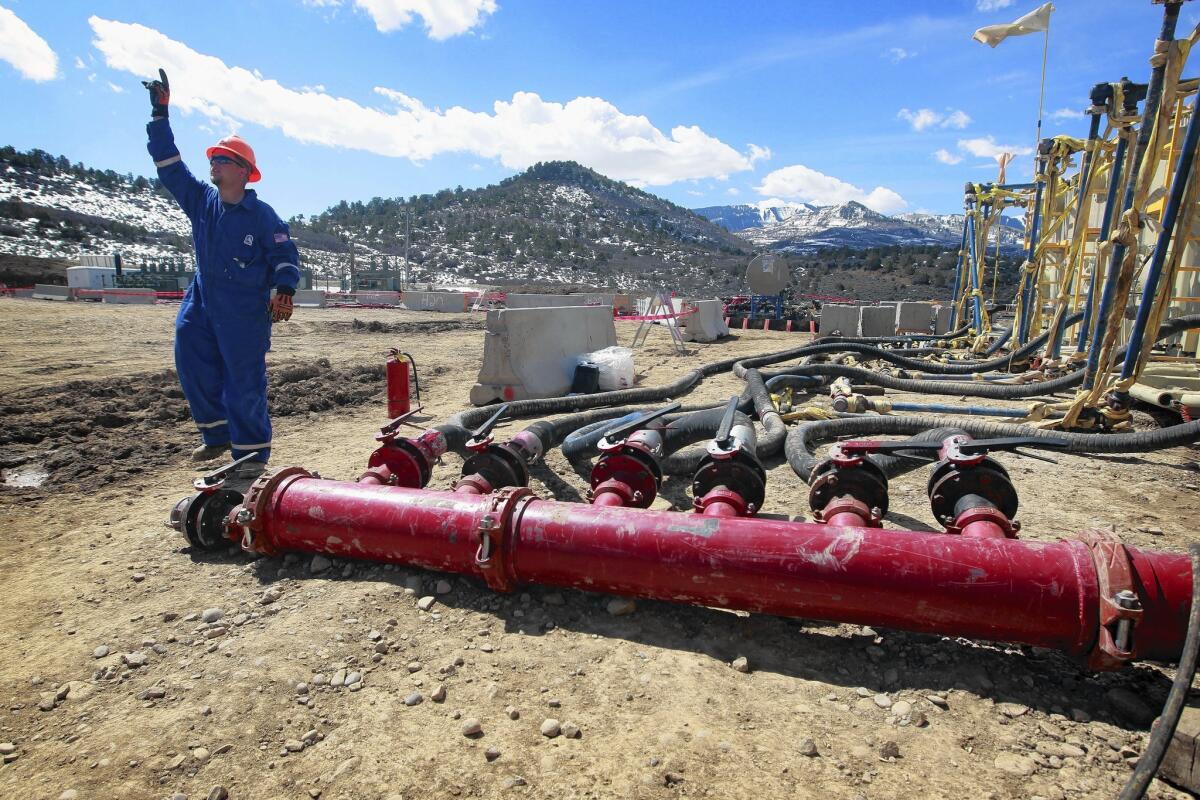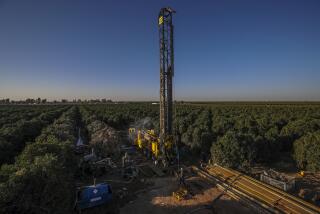In parched states, fracking’s thirst grows

GREELEY, Colo. — In this parched farming region, where the land flattens out and every drop of water is precious, another player has lined up at the spigot.
On a recent sunny afternoon, a huge cylindrical tanker truck rolled up to a red city fire hydrant and driver Jose Ofornio hopped out. With well-practiced efficiency he hooked hose to hydrant and began to fill. And fill.
“It’s really bad in the mornings,” Ofornio said, noting that trucks often have to wait in line for their turn. This was his third trip of the day. In less than 15 minutes, thousands of gallons of water gushed into his tank and was shuttled 50 miles to a drilling site, where it would be blasted into the ground along with sand and chemicals to free a bounty of oil and gas in a process called hydraulic fracturing, or fracking.
According to the petroleum industry, most new wells in this country now use fracking to coax an average of 250 barrels of oil or 1.3 million cubic feet of natural gas from the ground per day. But that can’t happen without water — about 3 million to 8 million gallons per well before extraction begins.
Last fall the Environment America Research and Policy Center estimated that at least 250 billion gallons of water had been used since 2005 in the estimated 80,000 wells in 17 states. Drought-prone Texas led the way with at least 110 billion gallons.
A study this month further alarmed environmentalists.
Ceres, a Boston-based nonprofit advocacy group that promotes sustainability to business leaders, reported that in the heavily drilled Permian Basin in West Texas and southeastern New Mexico, 87% of the wells were in high or extremely high water-stress areas, meaning the vast majority of available water was already allocated. And that basin overlaps the nation’s most important agricultural water supply, the Ogallala aquifer, yet water use for fracking there is forecast to double by 2020.
But drilling booms on. And nowhere is that more apparent than in Greeley, smack in the heart of Weld County — thought to have more oil and gas wells than any county in the nation, with just over 21,000. Within Greeley’s city limits alone there are 431.
The historic city of 95,000 about an hour north of Denver, along Colorado’s fast-growing Front Range, has entered into a purchase agreement with oil and gas companies to sell off some of its surplus water to satisfy the thirsty fracking business, even though parts of the West are reeling from drought. Thirty-five hydrants have been set aside, fixed with meters to keep tabs.
In some places, fracking relies on brackish or recycled water, but in Greeley it is all fresh. And the oil and gas companies that have set up shop here are willing to pay dearly for it — 100 times more than farmers do. In 2012, the most recent year for which numbers are available, Greeley pocketed just over $4 million.
“It’s an unexpected cash inflow,” said Jon Monson, the city’s water and sewer director. He also noted that even though the region is very dry, so far this year conditions aren’t bad enough to trigger an official drought designation, which would prompt tightening for everyone.
As fracking escalated in Weld County over the last few years, so did the amount of water bought from Greeley. In 2007, the city sold 636 acre-feet, or 207 million gallons of water, to oil and gas firms. By 2012 that number had risen to 513 million gallons, Monson said.
He noted that the oil and gas companies were not buying the actual rights to the city’s water nor taking away from residents or farmers, many of whom already own individual water rights. Each year the city gets a varying allocation from its water rights. In 2012 that totaled 12 billion gallons.
Though some residents might balk that they are under mandatory restrictions as surplus water is being sold, Monson said the restrictions had been in place for more than a century, dating to the city’s earliest days.
“I’m not creating a water supply for oil and gas,” he said.
Larry Hoozee, a 61-year-old farmer and rancher in Weld County, isn’t sure what to think. He runs about 300 cattle on 3,000 acres and grows wheat and hay. Two decades ago he sunk a well nearly 1,000 feet deep to tap water for his operation, and it’s always provided plenty. Now, as drilling continues to grow in his county, he wonders whether there will be enough water to go around.
“I just don’t know how big that pool of water is down there,” he said.
In southeastern Colorado, which has been in drought’s grip since 2010, rancher Leslie Watts, 64, said some of his neighbors were considering selling their water rights directly to the oil and gas companies operating nearby.
“People I know have the opportunity to sell their water rather than grow a crop in marginal conditions. It’s all about the dollar,” Watts said. “Some would say that’s greed. Some would say it’s survival.”
Doug Flanders, director of policy for the Colorado Oil and Gas Assn., an industry trade group, said the amount of water being used annually by drilling operations statewide was 0.08%, or roughly 6.5 billion gallons — a tiny fraction compared with other users, especially agriculture, which needs about 85%. But he acknowledged that water use by the industry was higher in heavy drilling areas. In Weld County, he said, it is about 2%.
Still, there is concern that oil and gas companies are dipping into a shrinking trough not just in Weld County but across the entire West, where drought is now being measured not in weeks and months but years.
The Ceres report showed that as of January, 56% of the 39,000 wells studied that used hydraulic fracturing were in parts of the U.S. experiencing “abnormally dry to exceptional drought” conditions, said Monika Freyman, the study’s author, who used federal drought-monitoring statistics to reach her conclusions.
The study also found that in 36% of the wells studied, there was significant groundwater depletion. And in Colorado and California, 97% and 96% of wells, respectively, were in regions with “high or extremely high water stress,” she said.
“An extremely deep-pocketed buyer has come into the game,” said Gary Wockner, program director of Save the Colorado River, a multi-state nonprofit group that works across the southwestern United States. “When fracking showed up about five years ago, it was a brand-new use of water in a system where all of the water was already spoken for. Since all water is already appropriated, it has to come from somewhere, be it a city, a farm or a river. Frackers can buy it up at any cost.”
Flanders, of the Colorado Oil and Gas Assn., calls the Ceres report agenda-driven, saying backers of the nonprofit are anti-drilling and that the findings unfairly singled out the fossil fuel industry.
“They are basically saying shut down oil and gas,” he said. “It’s not as if we’re using water for something superfluous. We’re creating energy, something people need and are using every day.”
Laura Belanger, a water resources and environmental engineer for the Boulder, Colo.-based Western Resource Advocates nonprofit, applauds the efforts by oil and gas companies toward better recycling of the water they use. Still, she is concerned because the true water use in drilling is difficult to assess. “It’s changing so quickly it’s hard to get a handle on it.”
Colorado’s oil and gas commission has predicted that as the amount of exploration and drilling increases, so will the amount of water needed. At the same time, population along the state’s Front Range region is exploding. Estimates by Western Resource Advocates predict it will grow by 70% in the next 40 years — which is like adding five new cities the size of Denver.
“If we look to the future, it’s going to get tighter and tighter,” Belanger said.
Six months ago, Kent Peppler, a fourth-generation farmer in Weld County who also serves as president of the Rocky Mountain Farmers Union, was featured in an Associated Press article complaining about how the oil and gas industry could drive prices for water so high it would elbow out already-hurting farmers.
But this week Peppler, who farms about 500 acres of corn, wheat and barley, said his water concerns had mostly eased. He then acknowledged that he had decided to allow oil development on his land.
“Maybe it’s a little bit hypocritical of me,” he said, “but you can’t deny the revenue it brings.”
There is little doubt a showdown looms.
Five cities to the west of Greeley — Broomfield, Boulder, Fort Collins, Longmont and Lafayette — have passed ordinances to ban or suspend fracking operations. Those ordinances are expected to be challenged in court.
Gov. John Hickenlooper, however, continues to support fracking, even once reportedly sipping a bit of fracking fluid with an oil company executive to prove it was safe.
Monson, the Greeley water and sewer director, said his city also once tried to ban drilling. It failed when the ordinance was overturned by the Colorado Supreme Court.
“We tried that route and lost,” he said. “So now we are trying to make it work.”
More to Read
Start your day right
Sign up for Essential California for news, features and recommendations from the L.A. Times and beyond in your inbox six days a week.
You may occasionally receive promotional content from the Los Angeles Times.






